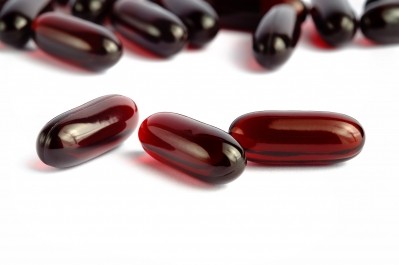Study shows Calanus oil may benefit blood pressure and heart health

Calanus oil, which is extracted from the copepods of the same name Calanus finmarchicus, contains the omega-3s EPA and DHA predominantly in the wax ester form (the oil is slightly viscous). The oil also contains astaxanthin, which gives its ruby color.
“The oil extracted from C. finmarchicus is ruby colored and slightly viscous, with [greater than] 86% of the fatty acids present as wax esters bound predominantly to aliphatic long-chain monounsaturated alcohols [mostly 20:1(n-9) and 22:1(n-11) alcohols], with minor amounts of free fatty acids, free fatty alcohols, and glycerides,” explained the authors of the new study in Prostaglandins, Leukotrienes and Essential Fatty Acids.
The new study, which used lab mice, found that eight weeks of supplementation with Calanus oil attenuated increases in blood pressure when the animals were exposed to angiotensin II, a potent vasoconstrictor.
“In the present study we show for the first time that dietary Calanus oil has protective effects on the vascular system in obese mice by preventing the rise in systolic blood pressure following acute exposure to [angiotensin II], suggesting that dietary intake of oil from the marine copepod Calanus finmarchicus could be a hypertension treatment option,” wrote the researchers, led by Wahida Salma from UiT The Arctic University of Norway.
“In addition, [angiotensin II]-induced tissue wasting, especially of adipose tissue, was significantly reduced in mice receiving dietary Calanus oil, indicative of lower energy requirements for tissue preservation during the stress imposed by [angiotensin II] exposure.”
Study details
The researchers fed C57BL/6J mice a high fat diet with or without supplemental Calanus oil (2%) for eight weeks. The animals maintained the diets for a further two weeks but were further randomized to receive either angiotensin II (Ang II) or saline.

Results showed that during the initial eight week period, the non-supplemented high fat diet-fed mice feigned significant body weight, but this was significantly attenuated in the Calanus oil group. However, administration of Ang II led to a sharp drop in body weight – or tissue wasting – in the non-supplemented animals, and this body weight drop was double that observed in the Calanus oil-supplement animals, indicating that the oil protected against tissue wasting.
Ang II also increased blood pressure in the non-supplemented animals, but these increases were not observed in the Calanus oil-supplemented group.
“As expected, infusion of Ang II produced hypertrophy and up-regulation of marker genes (mRNA level) of both hypertrophy and fibrosis in cardiac muscle, but this response was unaffected by dietary Calanus oil,” added the researchers. “Fibrosis and inflammation were up-regulated also in the aorta following Ang II infusion. However, the inflammatory response was blocked by Calanus oil supplementation.”
“These results suggest that dietary intake of oil from the marine copepod Calanus finmarchicus could be a beneficial addition to conventional hypertension treatment,” wrote the researchers.
“The compound attenuates inflammation and the severe metabolic stress caused by Ang II infusion. Although the present study suggests that the anti-hypertensive effect of the oil (or its n-3 PUFAs constituents) is related to its anti-inflammatory action in the vessel wall, other mechanisms such as interaction with intracellular calcium mechanisms or a direct antagonistic effect on Ang II receptors should be examined.”
Source: Prostaglandins, Leukotrienes and Essential Fatty Acids
May 2016, Volume 108, Pages 13-21, doi: 10.1016/j.plefa.2016.03.006
“Dietary Calanus oil antagonizes angiotensin II-induced hypertension and tissue wasting in diet-induced obese mice”
Authors: W. Salma et al.
















